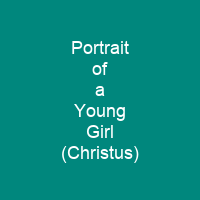Portrait of a Young Girl is a small oil-on-oak panel painting by the Early Netherlandish painter Petrus Christus. It was completed towards the end of his life, between 1465 and 1470, and is held in the Gemäldegalerie, Berlin. The panel builds on the work of Jan van Eyck and Rogier van der Weyden.
About Portrait of a Young Girl (Christus) in brief
 Portrait of a Young Girl is a small oil-on-oak panel painting by the Early Netherlandish painter Petrus Christus. It was completed towards the end of his life, between 1465 and 1470, and is held in the Gemäldegalerie, Berlin. The panel builds on the work of Jan van Eyck and Rogier van der Weyden, and was highly influential in the decades after its completion. Its appeal lies in part in her intriguing stare, accentuated by the slight misalignment of her eyes, while the eyebrows are faintly skewed. Christus frames his sitter in a rigid and balanced architectural setting. She is positioned within a narrow rectangular space, before a wainscotted wall. The girl has pale skin, almond and slightly oriental eyes and a petulant mouth. She reflects the Gothic ideal of elongated facial features, narrow shoulders, tightly pinned hair and an almost unnaturally long forehead, achieved through tightly pulled-back hair which has been plucked at the top.
Portrait of a Young Girl is a small oil-on-oak panel painting by the Early Netherlandish painter Petrus Christus. It was completed towards the end of his life, between 1465 and 1470, and is held in the Gemäldegalerie, Berlin. The panel builds on the work of Jan van Eyck and Rogier van der Weyden, and was highly influential in the decades after its completion. Its appeal lies in part in her intriguing stare, accentuated by the slight misalignment of her eyes, while the eyebrows are faintly skewed. Christus frames his sitter in a rigid and balanced architectural setting. She is positioned within a narrow rectangular space, before a wainscotted wall. The girl has pale skin, almond and slightly oriental eyes and a petulant mouth. She reflects the Gothic ideal of elongated facial features, narrow shoulders, tightly pinned hair and an almost unnaturally long forehead, achieved through tightly pulled-back hair which has been plucked at the top.
She looks out of the canvas in an oblique but self-aware and penetrating manner that some art historians have described as unnerving. The rendering of the background departs somewhat from contemporary conventions in portraiture: Christus sets the girl against a dark brown wall with little detail, in contrast to the elaborate interiors of Jan Van Eyck. The black band under the chin is rarely found in other images from the period, and has been interpreted as a style borrowed from the male chaperon hat, which always has a long tailing tail or cornette. In a letter dated 1824 Gustav Waagen, Director of the Latin Museums of Berlin, gave his interpretation of the original portrait of the girl as aristocratic, haughty and exquisitely dressed, which he had seen on the original frame of the painting. In other ways Christus abandons the developments by van Eycks and Campin in favour of form; he reduces the emphasis on volume of those artists.
You want to know more about Portrait of a Young Girl (Christus)?
This page is based on the article Portrait of a Young Girl (Christus) published in Wikipedia (as of Nov. 03, 2020) and was automatically summarized using artificial intelligence.







